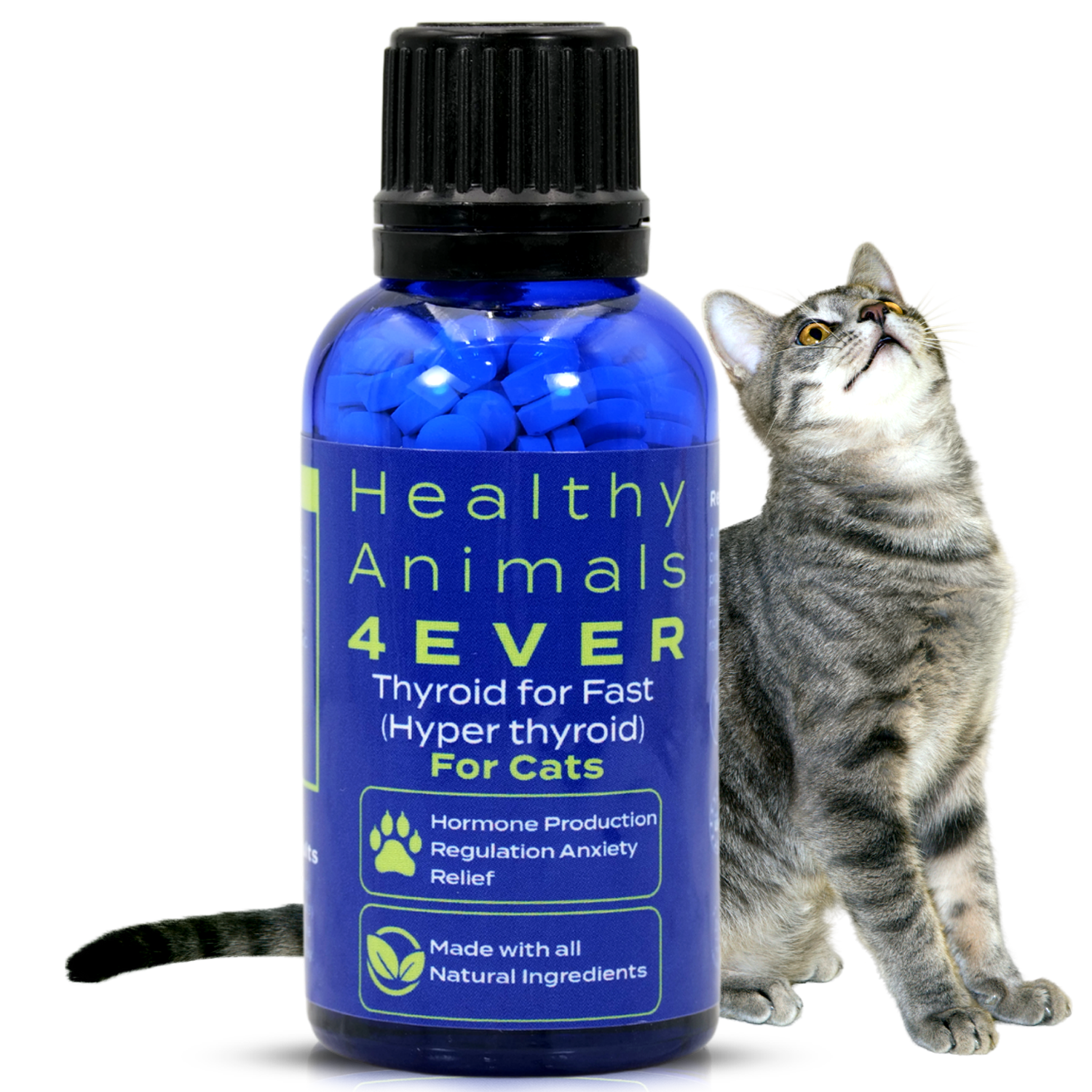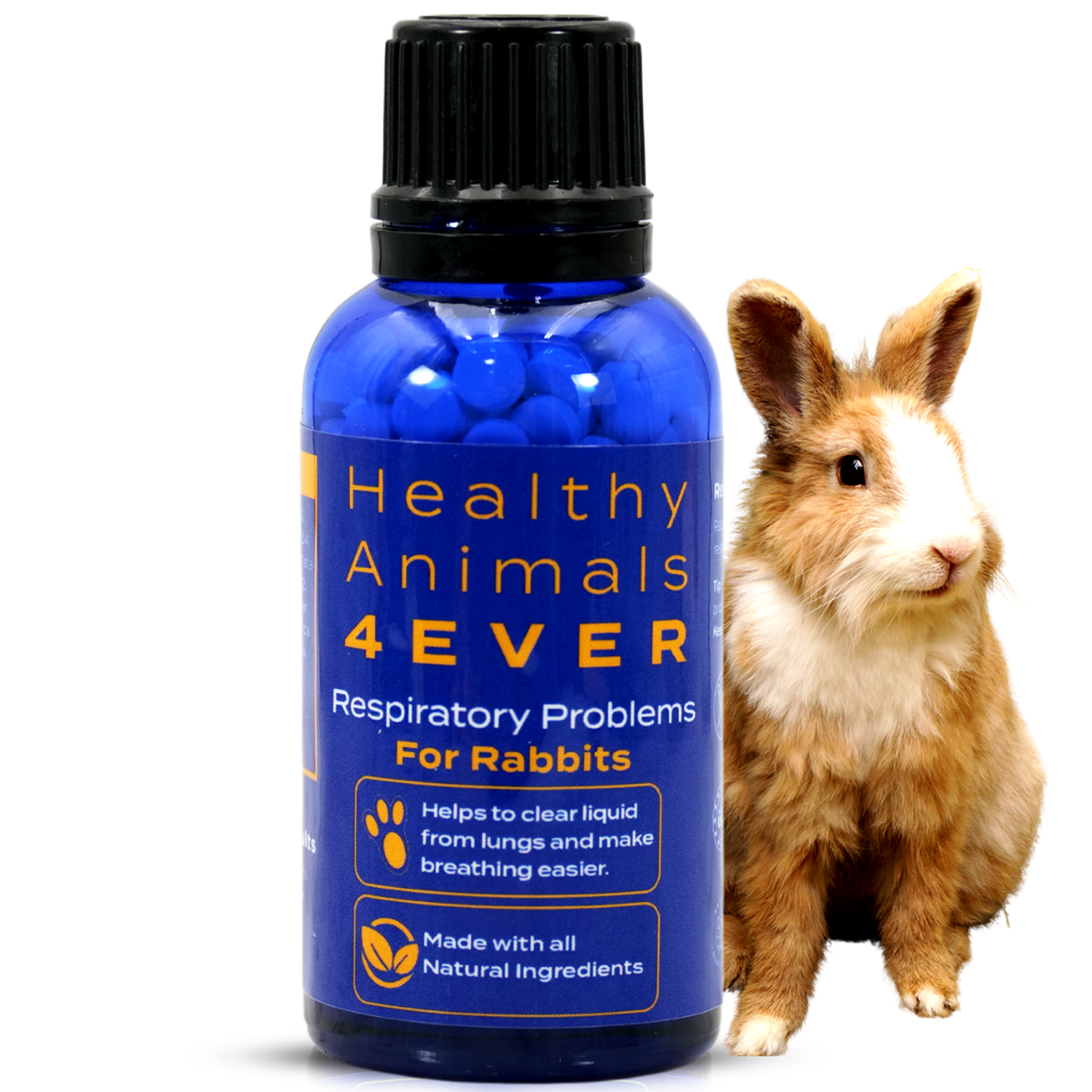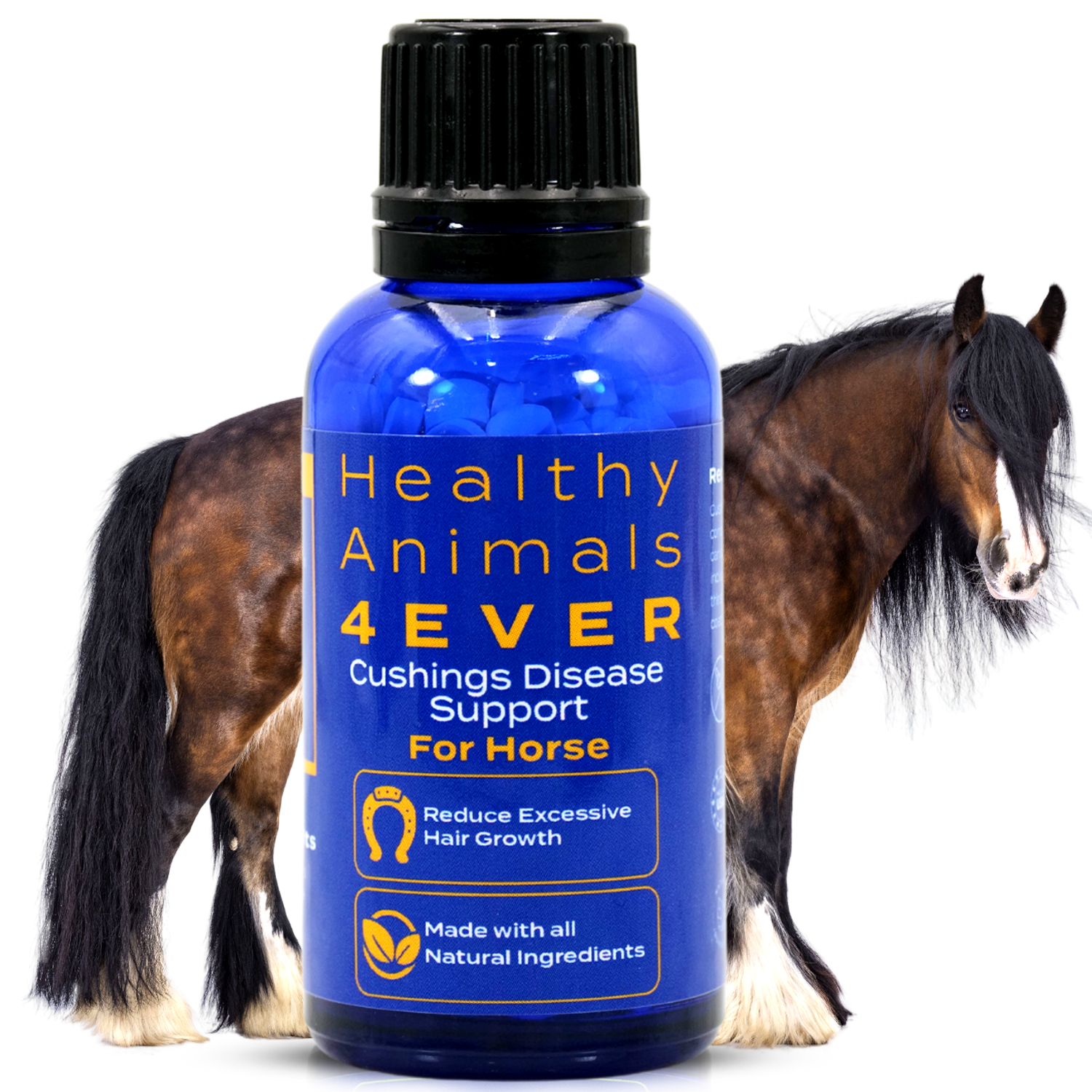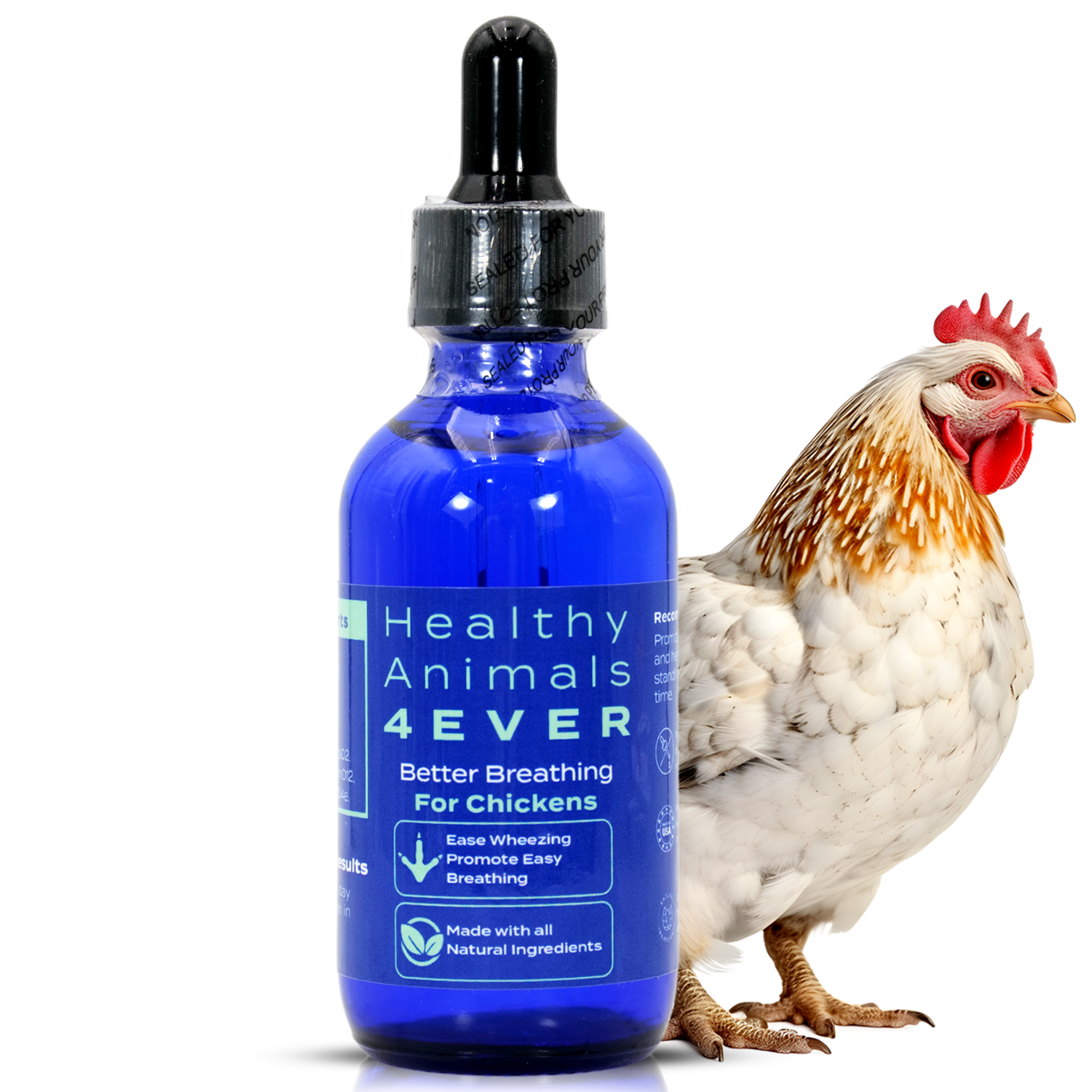Everything You Need to Know About Equine Cushing's Syndrome (PPID): Causes, Symptoms, Treatment & Natural Care
If you’ve been around horses long enough, you’ve probably heard someone mention Cushing’s disease. Maybe you’ve had a senior horse start growing a weirdly long coat, or you’ve seen a normally steady gelding suddenly come down with laminitis. It’s one of those conditions that quietly shows up and raises a lot of questions.
What exactly is PPID in horses? How serious is it? What can you do to manage it or prevent it altogether?
That’s what this blog is all about.
We’ll walk through what Equine Cushing's Syndrome is, how it’s diagnosed, what treatment options are out there (both conventional and natural remedies), and how you can support your horse day-to-day.
Cushing’s Disease Support is a natural remedy for Cushing's disease. Promotes regular hormone levels. Helps minimize excessive hair growth. Encourages healthy weight management. Safe and gentle for all horse breeds.
1. What Is Cushing’s Disease in Horses?
Cushing’s Disease, officially known as Pituitary Pars Intermedia Dysfunction (PPID), is one of the most common hormonal disorders seen in older horses. It’s a condition that affects how their bodies regulate certain hormones.
It’s not contagious, not caused by anything you did wrong, and it’s not a new disease; just something we’ve gotten better at recognizing and managing.

2. Causes and Risk Factors
Let’s talk about why horses get Cushing’s Disease, or more accurately, Pituitary Pars Intermedia Dysfunction (PPID). The root issue is a hormone imbalance caused by changes in the brain as horses age.
In a healthy horse, the pituitary gland (a tiny structure at the base of the brain) works like a control center for hormone production. But in horses with PPID, a part of the pituitary called the pars intermedia becomes overactive. It starts pumping out too much of certain hormones, which throws the horse’s entire system out of balance.
This overactivity is often due to degeneration of dopamine-producing neurons in the brain. Dopamine is like a messenger that tells the pituitary to stay in check. When there’s not enough dopamine, the pituitary goes rogue and starts misfiring.
Why does this happen?
The biggest factor is age. Most horses diagnosed with Cushing’s are older, typically over 15, and very commonly in their 20s. But younger horses can develop PPID too, so it’s not something to completely rule out just because a horse is still active or doesn’t have a gray muzzle.
Other risk factors can include:
-
Breed tendencies: Ponies and certain hardy breeds (like Morgans and Arabians) seem to be more prone.
-
Chronic stress or illness: Long-term stress on the horse’s body from poor diet, pain, or metabolic issues may increase vulnerability.
-
Insulin resistance: This is often tied into Cushing’s, either as a cause, a result, or both. The two conditions frequently go hand-in-hand.
There’s still a lot we don’t fully understand about what triggers PPID, but we do know that catching it early and managing it well makes a huge difference in a horse’s quality of life.

3. Signs and Symptoms
Recognizing the symptoms of equine Cushing's disease can be challenging, especially in the beginning. The signs can be subtle and easy to brush off as “just getting older.” But the earlier you spot it, the better chance you have at slowing the progression and helping your horse feel more comfortable.
Here’s what to look out for:
The classic signs:
-
Long, wavy, or thick coat that doesn’t shed out properly (also called a “hairy coat” or hirsutism). This is one of the most recognizable signs of Cushing’s. If your horse is still hanging onto a winter coat in the heat of summer, it’s worth asking your vet about.
-
Increased drinking and urination. If your horse is emptying water buckets faster than usual or making swampy stalls more often, their kidneys may be working overtime due to hormonal changes.
-
Muscle loss along the topline, pot-bellied appearance, or overall loss of condition, especially if appetite hasn’t changed.
-
Lethargy or a drop in performance. Your once-forward horse might start feeling a bit “flat” under saddle or seem generally less interested in work or play.
Other symptoms to watch for:
-
Laminitis (hoof pain and inflammation), sometimes recurring or with no clear cause. This is one of the more serious complications and can even be life-threatening if not addressed.
-
Increased susceptibility to infections like rain rot, abscesses, or sinus issues.
-
Delayed healing from injuries or wounds.
-
Abnormal fat deposits, especially around the eyes or neck (also called “cresty neck”).
Laminitis Support is a natural remedy for horse Laminitis. Recommended for inflamed hooves, pain, and discomfort. Supports healthy hoof growth. All-natural formula. Suitable for horses of all ages and activity levels. Easy to take.
The tricky part is that these symptoms don’t always show up all at once. Some horses might only display one or two for months (or even years) before things start to snowball. Others might have a sudden, dramatic episode that brings the condition to light quickly (like a bad laminitis flare-up).
That’s why it’s so important to know your horse really well. Small changes in behavior, appearance, or attitude can be early red flags. And if something feels “off,” bring it up with your vet.

4. Diagnosis
So, you’re seeing some changes in your horse (like a thick coat that won’t shed) and now you’re wondering: Could it be Cushing’s?
Getting a solid diagnosis is the next step, and while it might sound complicated, your vet has some pretty reliable tools to help figure things out.
What the vet is looking for
First off, your vet will likely start with a thorough physical exam. They’ll look at your horse’s overall condition, feel for muscle loss or abnormal fat deposits, ask about changes in behavior, water intake, hoof issues, and more. Often, this conversation alone gives a lot of useful clues.
Common diagnostic tests:
-
ACTH test: This is the most common and widely used test for diagnosing PPID in horses. It measures the level of adrenocorticotropic hormone (ACTH) in your horse’s blood. Horses with PPID tend to have elevated levels because the pituitary gland is overproducing it.
Sometimes the test is done with a TRH stimulation test, which adds a small dose of thyrotropin-releasing hormone to see how the horse’s body responds. If the ACTH level spikes significantly after the TRH, it helps confirm the diagnosis, especially in early or borderline cases. -
Other tests: Depending on your horse’s symptoms, your vet might also check insulin and glucose levels. This is because many horses with PPID also have insulin dysregulation, which increases the risk of laminitis.
These tests are usually done in the morning, and your vet may want to repeat them at different times of year. That’s because ACTH levels can naturally fluctuate with the seasons (especially in the fall). Vets are trained to interpret these changes, but it’s something to be aware of if you’re testing in September or October.
Is testing really necessary?
In short, yes. Some horse owners try to manage suspected Cushing’s symptoms without testing, but the downside is that you don’t have a clear baseline to work from. Testing not only confirms what’s going on, but it also gives you something to measure treatment effectiveness against later.
Plus, diagnosing early can help you avoid serious complications like laminitis or infections.

5. Conventional Treatments
The go-to treatment for Cushing's disease in horses is a drug called pergolide, sold under the brand name Prascend. It’s not a cure (PPID is a progressive condition), but it can slow things down and ease many uncomfortable symptoms.
It works by replacing the missing dopamine in the brain, which helps “calm down” the overactive pituitary gland.
It’s given as a daily tablet, and most horses tolerate it well. You can hide it in a treat, crush it into their grain, or use a pill popper if your horse is picky. (A bit of apple sauce or molasses can help if you’re dealing with a suspicious sniffer.)
Side effects and what to expect
Some horses go through a short adjustment period when they first start Prascend. This is sometimes called the “pergolide veil”; you might notice your horse acting a little lethargic or off in the first week or two. This usually passes pretty quickly, but it’s something to keep an eye on.
If the side effects don’t fade, your vet might adjust the dose or try easing into it more slowly.

6. Natural and Holistic Approaches
There’s a lot you can do alongside conventional medication (or sometimes even before medication is needed) through natural support and good old-fashioned horse care.
Now, just to be clear: natural doesn’t mean “no vet needed.” PPID is a serious condition. But when used thoughtfully, natural remedies for Cushing's in horses can reduce symptoms, support overall health, and improve your horse’s comfort and vitality.
Diet is a big one
Horses with Cushing’s are often insulin-resistant or prone to it, which means managing sugar and starch intake is huge.
That means:
-
Horse feed for Cushing's disease should not be sweet
-
No sugary treats
-
Limited or no fresh pasture, especially during high-sugar times (like spring grass or fall flushes)
Instead, focus on:
-
Low NSC hay (NSC = non-structural carbohydrates, aka sugars and starches)
-
Soaked hay (this can help reduce sugar content)
-
A balanced vitamin and mineral supplement; supplements for horses with Cushing's can be very helpful, especially if the diet is restricted
Herbal support
There are a few herbs that have been traditionally used to support horses with equine Cushing's syndrome. These can be helpful as part of a supportive plan:
-
Chaste tree berry (Vitex agnus-castus): This is the most commonly used herb for PPID. Some studies suggest it may help regulate hormone function, especially in early or mild cases. Some owners try it before starting Prascend, or alongside it for extra support.
-
Milk thistle: This herb supports liver function, which can be beneficial for horses with hormonal imbalances.
-
Adaptogens like ashwagandha or ginseng (used with guidance): These can help the body handle stress more efficiently, although more research is needed in horses.
Before starting any herbs, talk to your vet, especially if your horse is on medication.

Homeopathy
Homeopathic remedies offer a gentle and holistic approach to supporting horses with Cushing’s disease (PPID). These formulas work by stimulating the body’s natural healing mechanisms without introducing harsh chemicals or causing side effects. Many owners turn to homeopathy either as a standalone support or in conjunction with conventional treatments like Prascend, since homeopathic remedies do not interfere with medications.
Our own natural Cushing’s Disease support formula is specially designed with safe, non-toxic ingredients that promote hormonal balance, help manage abnormal hair growth, and support overall vitality. Free from GMOs, gluten, preservatives, and chemicals, it’s ideal for long-term use across all breeds.
Other holistic options
-
Acupuncture and chiropractic care can support comfort and help manage pain or stiffness, especially in older horses who may also have arthritis.
Arthritis Support is a natural remedy for arthritis in horses. Helps with arthritis pain and inflammation. Provides targeted joint health support. All-natural formula. Safe and gentle for all horse breeds.
- Hoof care and dentistry are essential components of any natural program. A horse that’s sore on their feet or has trouble chewing won’t benefit from herbs or clean feed alone.

7. Lifestyle and Management Tips
Ultimately, the best natural approach is a lifestyle that supports whole-body wellness! Clean feed, low stress, gentle movement, good companionship, and attentive care go a long, long way.
Grooming and coat care
One of the most common symptoms of PPID is that long, thick coat that won’t shed out in spring. This isn’t just a cosmetic thing, it can lead to overheating and skin issues.
Regular grooming is a must, and many horses benefit from body clipping once or twice a year. If your horse gets hot easily or struggles to shed, clipping can help them stay cool and comfortable.
Make sure they have shade, access to clean water, and a way to get out of the elements. PPID horses are often more sensitive to heat and cold.
Skin Conditions Support offers natural support for horses' skin health. Recommended for skin issues like itching, redness, and inflammation. Promotes healthy and comfortable skin. All-natural formula. Safe and gentle for all horse breeds.
Movement matters
Horses with Cushing’s do best when they keep moving, even just a little. Turnout is ideal, especially if they’re prone to stiffness or muscle loss. Just be careful with pasture access if insulin resistance or laminitis is a concern. Dry lots or well-managed grazing muzzles can help balance freedom and safety.
If they’re cleared by your vet, light riding or groundwork can keep them fit, engaged, and mentally sharp. Even short walks can do wonders for circulation and mood.
Hoof care is crucial
Laminitis is one of the most serious risks with Cushing’s horses, so you’ll want to be on top of hoof care. That means:
-
Regular trims by a knowledgeable farrier
-
Watching for subtle changes like warmth, digital pulse, or reluctance to move
-
Providing soft, supportive footing when needed
Hoof Issues Support is a natural remedy for hoof-related issues. Helps with cracked hooves, brittleness, and discomfort during movement. Promotes healthy hoof growth while soothing irritation. All-natural formula. Safe and gentle for all horse breeds.
Manage stress gently
Stress isn’t always obvious, but it can affect a horse with hormonal issues. Try to keep routines consistent, herd mates calm, and environments peaceful.
Some horses benefit from companions, while others prefer their own space. Observe what makes your horse happiest and adjust when possible.
Track the little things
Keep a notebook (or use an app) to track changes in:
-
Water intake
-
Coat condition
-
Behavior and mood
-
Appetite
-
Laminitis signs
These notes help you catch early warning signs and give your vet helpful information when tweaking treatment plans.

8. How to Prevent Cushing's Disease in Horses
There’s no guaranteed way to prevent equine Cushing's syndrome, especially since age is the biggest factor. However, there’s a lot you can do to spot it early, slow down its progression, and keep your horse healthier for longer.
Keep up with routine vet checks
This might sound basic, but it is one of the most effective prevention tools you have. A thorough annual exam (or even twice a year for older horses) gives your vet the chance to spot early red flags, like changes in muscle tone, coat texture, or weight.
Even if your horse seems perfectly fine, baseline bloodwork can catch subtle shifts in hormone levels before symptoms show up. Vets are starting to recommend routine ACTH testing for horses over age 15, especially those at risk for insulin issues.
Watch for early, subtle signs
The earliest signs of PPID can be easily dismissed if you’re not looking for them. For example:
-
Is your horse just “getting older,” or is that long winter coat a little too stubborn?
-
Are they slowing down under saddle, or is it early fatigue from muscle loss?
-
Are they drinking more because it’s hot, or is something hormonal going on?
Trust your gut. If something feels off, bring it up with your vet.
Support metabolic health
PPID often overlaps with Equine Metabolic Syndrome (EMS), so keeping your horse’s metabolism in check is another way to reduce the risk, or at least the complications.
This means:
-
Maintaining a healthy body condition (watch for that “cresty neck”)
-
Avoiding sugary feeds and managing pasture access
-
Encouraging gentle, regular movement
-
Monitoring for signs of insulin resistance (like recurring laminitis)
Don’t wait for a crisis
Too often, Cushing’s only gets diagnosed after a horse suffers a serious bout of laminitis, loses a ton of weight, or gets hit with back-to-back infections. By that point, things are already more complicated and harder to turn around.
So if you have a senior horse, or one that seems “a little off” in a way you can’t quite explain, it’s absolutely worth having the Cushing’s conversation sooner rather than later.
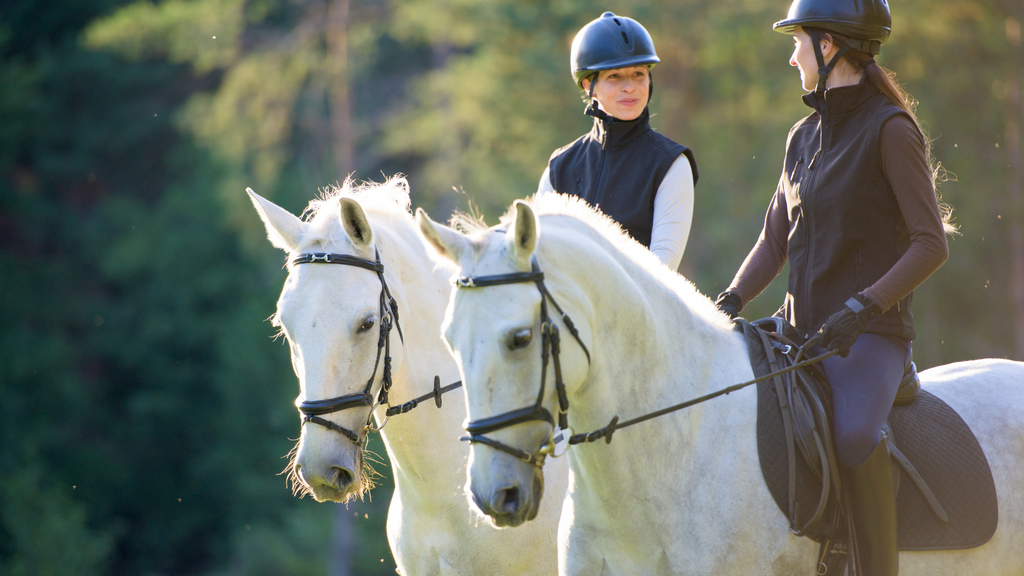
9. Living with a Horse with Cushing’s
Living with a horse who has Cushing’s means being more tuned in. But once you settle into the rhythm, it becomes just another part of caring for your horse.
You’ll likely have a routine that includes:
-
Medication (if prescribed)
-
A careful diet
-
Watching for seasonal coat changes
-
Keeping an eye out for subtle shifts in behavior or energy
Riding and activity
If your horse is feeling good, there’s no reason you can’t continue riding or enjoying time together. In fact, light exercise can help them stay fit, mentally stimulated, and metabolically healthy.
Just be flexible. Some days your horse may feel a little slower or need a break; on other days, they may act like their old self.
Support matters
Managing a chronic condition like Cushing’s can sometimes feel confusing. There’s a lot of conflicting advice out there, especially when it comes to natural vs. pharmaceutical approaches.
That’s why it helps to connect with others; try local horse groups, online communities, or social media forums. Other owners get it. They’ve been through the trial and error, the ups and downs, and often have helpful advice.

The Bottom Line
Equine Cushing's syndrome is a manageable, common condition that affects a lot of horses as they age. And while it can be frustrating at first, most horses with PPID go on to live full, happy lives with the right care. The key is to stay observant, get ahead of symptoms when you can, and work with your vet to create a treatment plan that fits your horse’s needs.



